by guest blogger Erica Goldemberg
Technology and current events are pushing the art world to go digital. How can artists plan and implement a successful online presentation of their work?
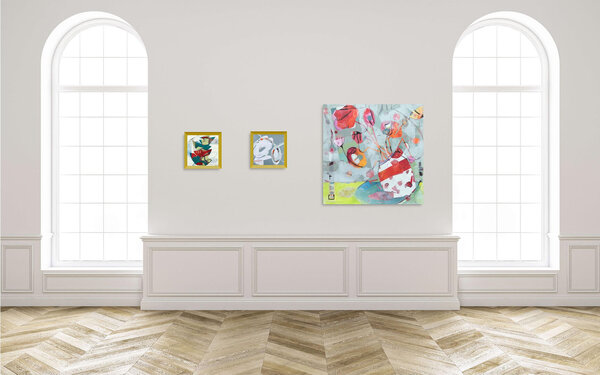
Artist credit: Dianna Fritzler
Since March of this year the COVID-19 crisis has forced the art world into an abrupt lockdown and artist outreach has been forced to go digital. In these times of travel restrictions and social distancing measures, online has become the only promotion and sales channel for much of the industry.
The transition to virtual space has required galleries and artists to adapt to challenges and new possibilities. From selling on Instagram to putting on virtual shows, adaptation is the key word to survival and future success.
The online exhibition format creates opportunities to establish valuable connections with new audiences and collectors through great storytelling. A curated set of artworks can work beautifully together, displayed with a short bio and, most importantly, with the artist’s story and intention. This is a great way to keep in touch with your mailing list, present new work and conduct business.
The thought of hosting a show was intimidating even before the pandemic, but don’t worry. These insights will guide you through.
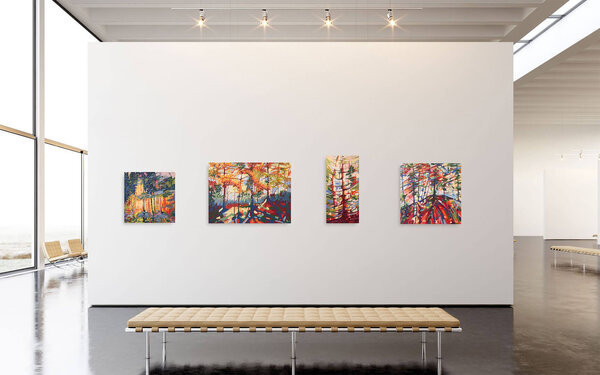
Artist credit: Marcia Wise
Provide an enhanced experience to the visitor
Your exhibition-style display can be placed as a blog post, or reside in a specific section of your artist website. Use the space to create an immersive experience. The artwork, text, and complementary material such as video and photos of the artist’s studio, should work together to create an inviting ambience.
As the artist, communicating your personal experience authentically will increase interest and reel in new collectors. It will also build trust and confidence among buyers. Focus on selling your personality first, rather than on selling a particular piece of art. As people come to know you and appreciate your work, they will gain a comfort level as a customer. This makes the prospect feel more secure when giving you their contact information or even making their first purchase.
Your presentation should be concise, but make sure to provide details for each piece of art including measurements, medium, provenance and pricing. Brand each website page clearly with your name and/or logo. And ensure that your contact information is easy to find. Imagine placing yourself in role of a new collector, and see things from their point of view. When seeing your work, are they easily able to access the right information to make an informed decision?
Invite potential clients to subscribe to your newsletter with an attractive pop-up banner and encourage them to follow you on your social media profiles. Continued communication will give you the chance to engage with viewers, and begin meaningful conversations about your work.
Create a beautiful space to shop
To create an exciting virtual viewing experience, a sense of spatial verisimilitude is a necessity. Presenting artworks on gallery walls from different perspectives increases collectors’ comfort when exploring art online. One of the hardest things about understanding art in a virtual world is getting a sense of the scale of the pieces. How large are these pieces? How do they look together? Show the relative size to other objects or humans, and how the pieces work together, on a wall at scale.
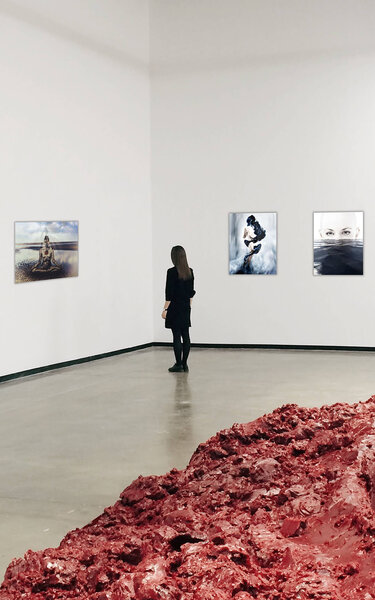
Artist credit: Jennifer Gleason
There are a few online apps that will help you achieve this with ease. We choose ArtPlacer because they offer perspective shots and a vast set of stock rooms, including art fair booths and galleries.
We recommend that you select a nice, bright wall to view all of the pieces together. Upload images of your work, enter their heights and drag and drop them onto the walls. The app will automatically portray them at scale. You can try different shadow and brightness options to match the quality of the light of the selected room, making the final result look more realistic.
Artworks can be virtually framed too. Select a matte and a frame for works on paper, or nothing at all for canvases. See how you like two pieces displayed side by side. Think about colors, size and scale. How do the pieces relate to one another? Do they match or contrast? Does one beautiful pop of color weight the whole thing?
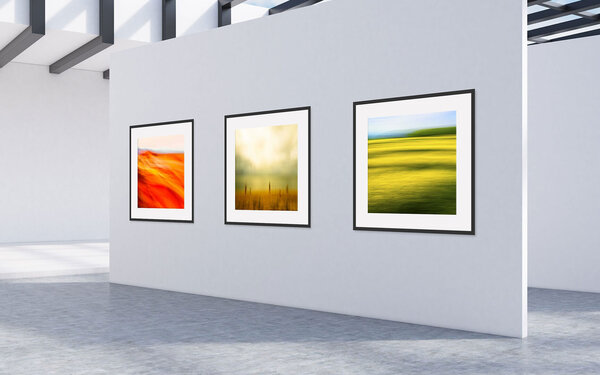
Artist credit: Bruce Peebles
Bring your virtual exhibition to life through a combination of subtle elements. Consider previews of gallery walls, framed and unframed options of the pieces, behind the scenes videos and close ups to get a sense of the medium and its texture.
Marketing your virtual show
Before launching the online exhibition of your art, ask trusted friends to take a look and provide feedback. They might spot missing information, or ask questions that will help you make some final adjustments.
Then, plan a social media campaign. Start by letting your followers know in advance that you will be having a show of your work. Think about images or design pieces that can work as teasers. It might be a picture of a new work or a shot of the artist creating in the studio.
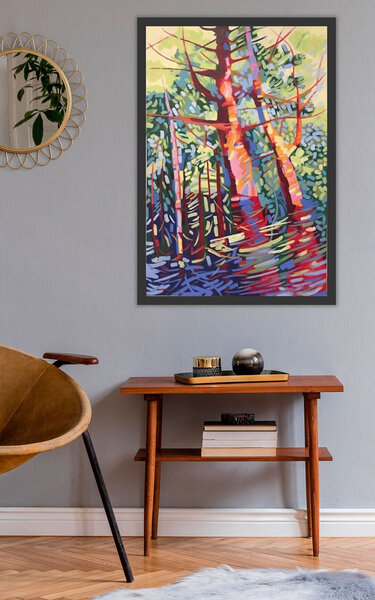
Artist credit: Marcia Wise
Consider changing your profile information to include your show dates and theme. Consider creating an Event on Facebook and invite friends. Share on both your personal and professional profiles. Make selfie video stories and reels for more engagement. Share your creative process or even the difficulties you encountered curating the show. Once the show opens, celebrate with live streaming!
Another strong pillar of your strategy should be email marketing. Reach out to your mailing list in a personalized way with an initial email to tell them what you’ve been up to and announce the date of the upcoming show. Remember to include some of the images you selected for your social media posts, and be coherent with the aesthetics. Send another email the morning of the day the show opens (the day your blog post or site goes live). Add last minute incentives like free shipping or a discount code!
The standard in the future
We believe that a combination of live and virtual exhibitions is what’s coming in the near future. Many tools have already appeared to help artists and galleries speak more loudly online. Going forward, we will probably see some new and exciting developments in the ways that art is presented online.
It’s key for galleries and artists to focus their energy on building relationships, no matter the means. That can be accomplished by engaging in conversation at a live event, writing emails, on the phone, via Zoom, on social media, through videos, you name it. At the end of the day, behind every screen, there’s a human being trying to connect and be entertained.
Erica Goldemberg is Marketing Director for ArtPlacer, an art staging app that creates previews of artworks in rooms. Go here to start a free trial. Enter ARTSYSHARK as the promo code for up to 30% at checkout.


Wonderful article. Thank you so much for sharing this valuable information.